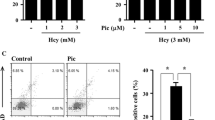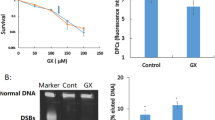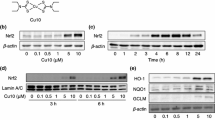Abstract
Zinc is the second-most abundant transition metal within cells and an essential micronutrient. Although adequate zinc is essential for cellular function, intracellular free zinc (Zn2+) is tightly controlled, as sustained increases in free Zn2+ levels can directly contribute to apoptotic endothelial cell death. Moreover, exposure of endothelial cells to acute nitrosative and/or oxidative stress induces a rapid rise of Zn2+ with mitochondrial dysfunction and the initiation of apoptosis. This apoptotic induction can be mimicked through addition of exogenous ZnCl2 and mitigated by zinc-chelation strategies, indicating Zn2+-dependent mechanisms in this process. However, the molecular mechanisms of Zn2+-mediated mitochondrial dysfunction are unknown. Here we report that free Zn2+ disrupts cellular redox status through inhibition of glutathione reductase, and induces apoptosis by redox-mediated inhibition of the mitochondrial adenine nucleotide transporter (ANT). Inhibition of ANT causes increased mitochondrial oxidation, loss of ADP uptake, mitochondrial translocation of bax, and apoptosis. Interestingly, pre-incubation with glutathione ethyl ester protects endothelial cells from these observed effects. We conclude that key mechanisms of Zn2+-mediated apoptotic induction include disruption of cellular glutathione homeostasis leading to ANT inhibition and decreases in mitochondrial ATP synthesis. These pathways could represent novel therapeutic targets during acute oxidative or nitrosative stress in cells and tissues.





Similar content being viewed by others
References
Atwood JL, Steed JW (2004) Encyclopedia of supramolecular chemistry. M. Dekker, New York
Bao S, Knoell DL (2006) Zinc modulates airway epithelium susceptibility to death receptor-mediated apoptosis. Am J Physiol Lung Cell Mol Physiol 290:L433–L441
Bauer G (2000) Reactive oxygen and nitrogen species: efficient, selective, and interactive signals during intercellular induction of apoptosis. Anticancer Res 20:4115–4139
Belzacq AS, Vieira HL, Verrier F, Vandecasteele G, Cohen I, Prevost MC, Larquet E, Pariselli F, Petit PX, Kahn A, Rizzuto R, Brenner C, Kroemer G (2003) Bcl-2 and Bax modulate adenine nucleotide translocase activity. Cancer Res 63:541–546
Bennett DR, Baird CJ, Chan KM, Crookes PF, Bremner CG, Gottlieb MM, Naritoku WY (1997) Zinc toxicity following massive coin ingestion. Am J Forensic Med Pathol 18:148–153
Bernal PJ, Leelavanichkul K, Bauer E, Cao R, Wilson A, Wasserloos KJ, Watkins SC, Pitt BR, St Croix CM (2008) Nitric oxide-mediated zinc release contributes to hypoxic regulation of pulmonary vascular tone. Circ Res 102:1575–1583
Bittsanszky A, Komives T, Gullner G, Gyulai G, Kiss J, Heszky L, Radimszky L, Rennenberg H (2005) Ability of transgenic poplars with elevated glutathione content to tolerate zinc(2+) stress. Environ Int 31:251–254
Brennan LA, Wedgwood S, Bekker JM, Black SM (2003) Nitric oxide activates p21ras and leads to the inhibition of endothelial NO synthase by protein nitration. DNA Cell Biol 22:317–328
Chan SHP, Barhour KL (1979) Membrane bioenergetics: based on the international workshop held at Cranbrook Schools, Bloomfield Hills, Michigan, July 5–7, 1979 in honor of Efraim Racker. Addison-Wesley, Reading
Cortese MM, Suschek CV, Wetzel W, Kroncke KD, Kolb-Bachofen V (2008) Zinc protects endothelial cells from hydrogen peroxide via Nrf2-dependent stimulation of glutathione biosynthesis. Free Radic Biol Med 44:2002–2012
Echtay KS, Murphy MP, Smith RA, Talbot DA, Brand MD (2002) Superoxide activates mitochondrial uncoupling protein 2 from the matrix side. Studies using targeted antioxidants. J Biol Chem 277:47129–47135
Farrow KN, Groh BS, Schumacker PT, Lakshminrusimha S, Czech L, Gugino SF, Russell JA, Steinhorn RH (2008) Hyperoxia increases phosphodiesterase 5 expression and activity in ovine fetal pulmonary artery smooth muscle cells. Circ Res 102:226–233
Fink B, Dikalov S (2002) Detection of superoxide with new cyclic hydroxylamine CMH in plasma, cells, isolated heart. Free Radic Biol Med 33:S366
Forman HJ, Torres M (2001) Redox signaling in macrophages. Mol Asp Med 22:189–216
Frutos-Vivar F, Nin N, Esteban A (2004) Epidemiology of acute lung injury and acute respiratory distress syndrome. Curr Opin Crit Care 10:1–6
Garcia-Ruiz C, Colell A, Morales A, Kaplowitz N, Fernandez-Checa JC (1995) Role of oxidative stress generated from the mitochondrial electron transport chain and mitochondrial glutathione status in loss of mitochondrial function and activation of transcription factor nuclear factor-kappa B: studies with isolated mitochondria and rat hepatocytes. Mol Pharmacol 48:825–834
Giron-Calle J, Zwizinski CW, Schmid HH (1994) Peroxidative damage to cardiac mitochondria. II. Immunological analysis of modified adenine nucleotide translocase. Arch Biochem Biophys 315:1–7
Hanson GT, Aggeler R, Oglesbee D, Cannon M, Capaldi RA, Tsien RY, Remington SJ (2004) Investigating mitochondrial redox potential with redox-sensitive green fluorescent protein indicators. J Biol Chem 279:13044–13053
Koh JY, Choi DW (1994) Zinc toxicity on cultured cortical neurons: involvement of N-methyl-d-aspartate receptors. Neuroscience 60:1049–1057
Lange A, Ausseil O, Segner H (2002) Alterations of tissue glutathione levels and metallothionein mRNA in rainbow trout during single and combined exposure to cadmium and zinc. Comp Biochem Physiol C Toxicol Pharmacol 131:231–243
Li Q, Sato EF, Kira Y, Nishikawa M, Utsumi K, Inoue M (2006) A possible cooperation of SOD1 and cytochrome c in mitochondria-dependent apoptosis. Free Radic Biol Med 40:173–181
Lunardi J, Attardi G (1991) Differential regulation of expression of the multiple ADP/ATP translocase genes in human cells. J Biol Chem 266:16534–16540
Machlin LJ, Bendich A (1987) Free radical tissue damage: protective role of antioxidant nutrients. Faseb J 1:441–445
Maret W (2003) Cellular zinc and redox states converge in the metallothionein/thionein pair. J Nutr 133:1460S–1462S
Markovich D (2001) Physiological roles and regulation of mammalian sulfate transporters. Physiol Rev 81:1499–1533
Novoselov VI, Amelina SE, Kravchenko IN, Novoselov SV, Yanin VA, Sadovnikov VB, Fesenko EE (2000) The role of peroxyredoxin in the antioxidant system of respiratory organs. Dokl Biophys 373–375:64–66
Nyborg JK, Peersen OB (2004) That zincing feeling: the effects of EDTA on the behaviour of zinc-binding transcriptional regulators. Biochem J 381:e3–e4
Peterson QP, Goode DR, West DC, Ramsey KN, Lee JJ, Hergenrother PJ (2009) PAC-1 activates procaspase-3 in vitro through relief of zinc-mediated inhibition. J Mol Biol 388:144–158
Shertzer HG, Racker E (1976) Reconstitution and characterization of the adenine nucleotide transporter derived from bovine heart mitochondria. J Biol Chem 251:2446–2452
Simons TJ (1991) Intracellular free zinc and zinc buffering in human red blood cells. J Membr Biol 123:63–71
Tang ZL, Wasserloos K, St Croix CM, Pitt BR (2001) Role of zinc in pulmonary endothelial cell response to oxidative stress. Am J Physiol Lung Cell Mol Physiol 281:L243–L249
Truong-Tran AQ, Carter J, Ruffin RE, Zalewski PD (2001) The role of zinc in caspase activation and apoptotic cell death. Biometals 14:315–330
Vesce S, Jekabsons MB, Johnson-Cadwell LI, Nicholls DG (2005) Acute glutathione depletion restricts mitochondrial ATP export in cerebellar granule neurons. J Biol Chem 280:38720–38728
Watson WH, Yang X, Choi YE, Jones DP, Kehrer JP (2004) Thioredoxin and its role in toxicology. Toxicol Sci 78:3–14
Wedgwood S, Black SM (2003) Molecular mechanisms of nitric oxide-induced growth arrest and apoptosis in fetal pulmonary arterial smooth muscle cells. Nitric Oxid 9:201–210
Wedgwood S, Mitchell CJ, Fineman JR, Black SM (2003) Developmental differences in the shear stress-induced expression of endothelial NO synthase: changing role of AP-1. Am J Physiol Lung Cell Mol Physiol 284:L650–L662
Wilson MR, Foucaud L, Barlow PG, Hutchison GR, Sales J, Simpson RJ, Stone V (2007) Nanoparticle interactions with zinc and iron: implications for toxicology and inflammation. Toxicol Appl Pharmacol 225:80–89
Wiseman DA, Wells SM, Wilham J, Hubbard M, Welker JE, Black SM (2006) Endothelial response to stress from exogenous Zn2+ resembles that of NO-mediated nitrosative stress, and is protected by MT-1 overexpression. Am J Physiol Cell Physiol 291:C555–C568
Wiseman DA, Wells SM, Hubbard M, Welker JE, Black SM (2007) Alterations in zinc homeostasis underlie endothelial cell death induced by oxidative stress from acute exposure to hydrogen peroxide. Am J Physiol Lung Cell Mol Physiol 292:L165–L177
Zalewski PD, Forbes IJ, Giannakis C (1991) Physiological role for zinc in prevention of apoptosis (gene-directed death). Biochem Int 24:1093–1101
Acknowledgments
This research was supported by a Ruth L. Kirschstein National Research Service Award Individual Fellowship, F32HL090198 (to D. A. Wiseman); National Institute of Health Grants HL-60190, HL-67841, HL-72123, HL084739, R21HD057406, and HL-70061, a Transatlantic Network Development Grant from Fondation LeDucq (all to S. M. Black), and an AHA Southeast affiliates Beginning Grant In Aid Award (09BGIA2310050, to S. Sharma).
Author information
Authors and Affiliations
Corresponding author
Rights and permissions
About this article
Cite this article
Wiseman, D.A., Sharma, S. & Black, S.M. Elevated zinc induces endothelial apoptosis via disruption of glutathione metabolism: role of the ADP translocator. Biometals 23, 19–30 (2010). https://doi.org/10.1007/s10534-009-9263-y
Received:
Accepted:
Published:
Issue Date:
DOI: https://doi.org/10.1007/s10534-009-9263-y




